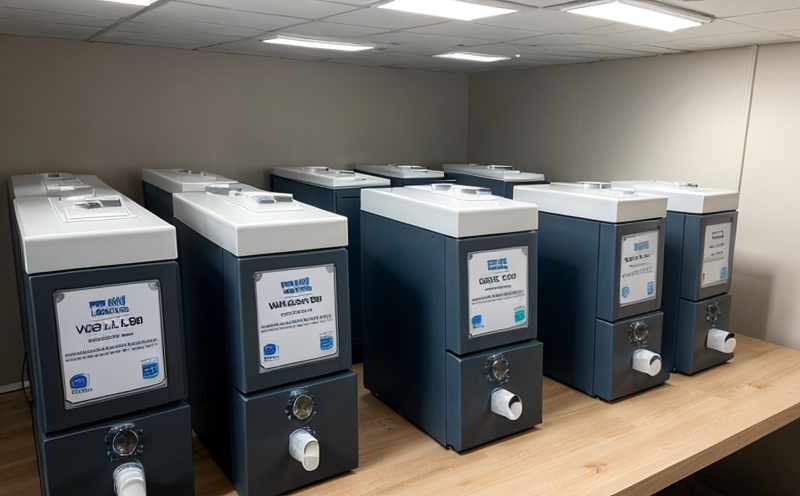Chemical off-gassing analysis of upholstery fabrics
The analysis of chemical off-gassing from upholstery fabrics is a critical process in ensuring both product quality and compliance with international standards. Upholstery fabrics are often treated or impregnated with various chemicals to enhance their performance, durability, and appearance. These treatments can include flame retardants, antimicrobials, pigments, and finishes that may release volatile organic compounds (VOCs) into the air during use.
This chemical off-gassing not only affects indoor air quality but also has implications for human health and safety. Excessive levels of formaldehyde, a common VOC released by upholstery fabrics, can lead to respiratory issues, allergies, and other adverse health effects. Therefore, it is crucial to monitor the release of these chemicals during their lifecycle.
The testing process involves several key steps: specimen preparation, analysis using advanced instrumentation such as gas chromatography-mass spectrometry (GC-MS), and compliance with international standards like ISO 16000-9 for formaldehyde emissions. The results provide valuable insights into the potential risks associated with the fabric's use.
For quality managers and compliance officers, this test ensures that products meet regulatory requirements such as those set by the U.S. Consumer Product Safety Commission (CPSC) or European Union regulations like REACH. R&D engineers can utilize these data to optimize formulations and improve product performance without compromising safety. Procurement teams benefit from this information in selecting suppliers who adhere to stringent quality control measures.
Understanding the specific composition of off-gassed chemicals helps manufacturers make informed decisions about raw materials, processing methods, and final product design. This knowledge allows for continuous improvement aimed at reducing environmental impact while maintaining or enhancing product performance.
The implications extend beyond just compliance; they also play a vital role in promoting sustainable practices within industries reliant on textiles. By minimizing harmful emissions during production and use phases, companies contribute positively to global efforts towards cleaner environments.
- Ensures regulatory compliance with international standards
- Reduces health risks associated with indoor air quality
- Promotes sustainable manufacturing processes
- Enhances product performance through optimized formulations
In summary, the chemical off-gassing analysis of upholstery fabrics is essential for maintaining high standards in textile production. It supports compliance with safety regulations while fostering innovation and sustainability within the industry.
Why It Matters
Chemical off-gassing analysis is vital for several reasons. Firstly, it directly influences indoor air quality, which has significant implications for occupant health and comfort. Poorly ventilated spaces can accumulate high concentrations of VOCs from fabrics, leading to symptoms such as headaches, dizziness, and nausea.
From a regulatory standpoint, compliance with standards like ISO 16000-9 is non-negotiable. Failure to meet these requirements could result in product recalls, legal action, and damage to brand reputation. Moreover, adhering to international guidelines demonstrates a commitment to responsible corporate citizenship and ethical business practices.
On an environmental level, reducing chemical emissions contributes positively to sustainability goals. By minimizing the release of harmful substances into the environment during the use phase, manufacturers can help mitigate pollution and promote healthier living spaces.
Why Choose This Test
- Promotes compliance with strict international standards
- Aids in identifying potential health hazards early on
- Supports continuous improvement in product development
- Enhances customer confidence through transparent testing processes
- Fosters a safer working environment for manufacturing personnel
- Contributes to overall sustainability initiatives within the industry
Choosing this test ensures that your products not only meet but exceed regulatory expectations, thereby building trust with consumers and stakeholders alike.
Environmental and Sustainability Contributions
The analysis of chemical off-gassing from upholstery fabrics plays a pivotal role in supporting environmental sustainability. By identifying and mitigating the release of harmful VOCs, particularly formaldehyde, this process helps reduce the overall ecological footprint associated with textile products.
Incorporating sustainable practices into manufacturing processes is increasingly important as consumers become more environmentally conscious. Reducing emissions during production not only benefits immediate health but also supports long-term environmental goals. This includes decreasing reliance on non-renewable resources and promoting circular economy principles through better resource management.
Furthermore, transparent reporting of test results allows for informed decision-making throughout the supply chain. Suppliers can use this information to select raw materials that minimize adverse impacts while enhancing product quality. Consumers gain peace of mind knowing they are contributing positively to global sustainability efforts when purchasing certified products.





